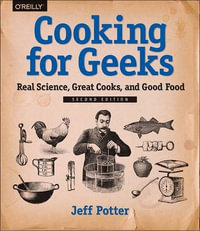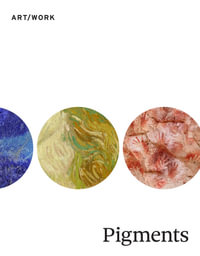
Mass Spectrometry Basics
By: Christopher G. Herbert, Robert A.W. Johnstone
Hardcover | 26 June 2002 | Edition Number 1
At a Glance
498 Pages
25.4 x 17.78 x 2.69
Hardcover
RRP $525.00
$371.50
29%OFF
or 4 interest-free payments of $92.88 with
orAims to ship in 7 to 10 business days
This unique reference makes some of the esoteric aspects of this important area of analysis more readily comprehensible to those who deal with analytical instruments but who have not been trained in mass spectrometry. It also serves as a refresher for practicing mass spectroscopists by clarifying principles to afford a better appreciation and application of this technology.
Industry Reviews
"This book is intended ... as a brief primer on the many flavors and applications of MS technology. As such, the novice will walk away with a taste of MS while the seasoned pioneer will see this book as a quick reference. ... [T]he book sets the reader up to read ... more complex books down the road. And each chapter is spiced with figures, tables, and schematics that help the reader understand how this technology comes together."
- Today's Chemist at Work
"...can be used by all categories of readership...The book is developmental in nature - beginning with basics of the process and proceeding stepwise to more detailed analyses of each aspect of the method...Highly recommended"
L. Andersson, Big Bend Community College, in CHOICE Magazine.
Promo Copy
| Chemical Ionization (CI) | p. 1 |
| The Ionization Process | p. 1 |
| Example of the Chemical Ionization Process | p. 1 |
| Other Reagent Gases | p. 2 |
| Other Ionization Routes | p. 3 |
| Uses of CI | p. 4 |
| Use of CI/EI in Tandem in GC/MS | p. 4 |
| Negative Ions | p. 5 |
| Conclusion | p. 5 |
| Laser Desorption Ionization (LDI) | p. 7 |
| The Ionization Process | p. 7 |
| Other Considerations on Laser Desorption Ionization | p. 9 |
| Use of a Matrix | p. 9 |
| Types of Laser | p. 10 |
| Secondary Ionization | p. 10 |
| Uses of Lasers | p. 11 |
| Conclusion | p. 12 |
| Electron Ionization (EI) | p. 13 |
| The Ionization Process | p. 13 |
| Mass-To-Charge Ratio (m/z) | p. 13 |
| The Mass Spectrum | p. 14 |
| The Ion Source | p. 14 |
| Isotopes | p. 16 |
| Conclusion | p. 16 |
| Fast-Atom Bombardment (FAB) and Liquid-Phase Secondary Ion Mass Spectrometry (LSIMS) Ionization | p. 17 |
| Introduction | p. 17 |
| Atom or Ion Beams | p. 18 |
| The Ionization Process | p. 18 |
| Properties of the Solvent (Matrix) | p. 20 |
| The Mass Spectrum | p. 21 |
| Conclusion | p. 22 |
| Field Ionization (FI) and Field Desorption (FD) | p. 23 |
| Introduction | p. 23 |
| Field Ionization | p. 23 |
| Design of the Needle Tip Electrode | p. 24 |
| Practical Considerations of Field Ionization/Field Desorption | p. 25 |
| Types of Compounds Examined by FI/FD | p. 27 |
| Conclusion | p. 27 |
| Coronas, Plasmas, and Arcs | p. 29 |
| Background | p. 29 |
| Electric Discharges in a Gas | p. 30 |
| Light and Dark Regions in the Discharge | p. 32 |
| Electric-Field Gradients across the Glow Discharge | p. 35 |
| Self-Sustaining Discharge | p. 36 |
| Sputtering | p. 36 |
| Effect of Electrode Separation on Discharge | p. 37 |
| Arcs | p. 37 |
| Effect of Gas Pressure on Discharge | p. 38 |
| Effect of Gas Flow on Discharge | p. 38 |
| Effect of Electrode Shapes on Discharge | p. 38 |
| Effect of Voltage Changes on Glow Discharge Characteristics | p. 39 |
| Overall Process | p. 43 |
| Conclusion | p. 43 |
| Thermal Ionization (TI), Surface Emission of Ions | p. 45 |
| Introduction | p. 45 |
| High Filament Temperatures | p. 18 |
| Thermochemistry of surface emission | p. 47 |
| Changing the Work Function (Activators) | p. 49 |
| Amount of Sample | p. 51 |
| Measurement of Ratios of Isotopic Abundances | p. 51 |
| Conclusion | p. 53 |
| Electrospray Ionization (ESI) | p. 55 |
| Introduction | p. 55 |
| Differential Solvent Removal | p. 56 |
| Multicharged ions | p. 57 |
| Uses of Electrospray | p. 58 |
| General Comments | p. 59 |
| Conclusion | p. 60 |
| Atmospheric-Pressure Ionization (API) | p. 61 |
| Background | p. 61 |
| The Ionization Process | p. 61 |
| Drying Gas | p. 62 |
| The Number of Ions | p. 63 |
| Conclusion | p. 63 |
| Z-Spray Combined Inlet/Ion Source | p. 65 |
| Introduction | p. 65 |
| The Initial Spray | p. 65 |
| Trajectories of Ions and Neutrals | p. 67 |
| Advantages | p. 68 |
| Conclusion | p. 69 |
| Thermospray and Plasmaspray Interfaces | p. 71 |
| Introduction | p. 71 |
| Differential Solvent Removal | p. 72 |
| Ion Yield | p. 73 |
| Nature of the Ions Produced | p. 73 |
| Uses of Plasmaspray and Electrospray | p. 74 |
| General Comments | p. 75 |
| Conclusion | p. 75 |
| Particle-Beam Interface | p. 77 |
| Background | p. 77 |
| The Nebulizer | p. 77 |
| The Evacuation Chamber | p. 77 |
| The First Skimmer | p. 78 |
| The Second Skimmer | p. 78 |
| The Ion Source | p. 79 |
| Ionization | p. 79 |
| Efficiency | p. 79 |
| Similarity to Other Interfaces | p. 79 |
| Conclusion | p. 80 |
| Dynamic Fast-Atom Bombardment and Liquid-Phase Secondary Ion Mass Spectrometry (FAB/LSIMS) Interface | p. 81 |
| Introduction | p. 81 |
| Atom or Ion Beams | p. 82 |
| Properties of the Solvent (Matrix Material) | p. 82 |
| Dynamic-FAB/LSIMS Interface | p. 83 |
| Types of Ions Produced | p. 86 |
| Conclusion | p. 86 |
| Plasma Torches | p. 87 |
| Introduction | p. 87 |
| Construction of the Plasma Torch | p. 88 |
| Plasma Flame | p. 89 |
| Temperature of the Plasma | p. 91 |
| Processes Occurring in the Plasma after Introduction of a Sample | p. 92 |
| Cold Plasma Conditions and the Plasma Cage | p. 94 |
| The Interface | p. 95 |
| Conclusion | p. 95 |
| Sample Inlets for Plasma Torches, Part A: Gases | p. 97 |
| Introduction | p. 97 |
| Problems of Sample Introduction | p. 97 |
| Introduction of Gases | p. 98 |
| Conclusion | p. 102 |
| Sample Inlets for Plasma Torches, Part B: Liquid Inlets | p. 103 |
| Introduction | p. 103 |
| Problems of Sample Introduction | p. 103 |
| Liquid Inlets | p. 104 |
| Direct Insertion Methods (Direct Solids Insertion, DSI) | p. 105 |
| Electrothermal Heating Methods (Electrothermal Vaporization, ETV) | p. 106 |
| Nebulizer Methods | p. 106 |
| Desolvation Chambers | p. 107 |
| Conclusion | p. 108 |
| Sample Inlets for Plasma Torches, Part C: Solid Inlets | p. 109 |
| Introduction | p. 109 |
| Problems of Sample Introduction | p. 109 |
| Introduction of Solids | p. 110 |
| Conclusion | p. 116 |
| Lasers and Other Light Sources | p. 117 |
| Introduction | p. 117 |
| Some Characteristics of Light as a Waveform | p. 120 |
| Nonlaser Light Sources | p. 122 |
| Laser Light Sources | p. 123 |
| Lasers in Mass Spectrometry | p. 134 |
| Conclusion | p. 136 |
| Nebulizers | p. 137 |
| Background | p. 137 |
| The Nature of an Aerosol | p. 137 |
| General Principles of Aerosol Formation | p. 138 |
| Pneumatic Nebulizers (PN) | p. 139 |
| Ultrasonic Nebulizers (USN) | p. 147 |
| Thermospray Nebulizers (TN) | p. 149 |
| Electrospray Nebulization (EN) | p. 150 |
| Spray and Desolvation Chambers | p. 152 |
| Conclusion | p. 152 |
| Hybrid Orthogonal Time-of-Flight (oa-TOF) Instruments | p. 153 |
| Introduction | p. 153 |
| Q/TOF | p. 153 |
| LC/TOF | p. 154 |
| AutoSpec-TOF | p. 154 |
| Conclusion | p. 154 |
| Hybrid Magnetic-Sector Time-of-Flight (Sector/TOF) Instruments | p. 157 |
| Introduction | p. 157 |
| AutoSpec-TOF Ion Optics | p. 158 |
| Magnetic/Electric-Sector Section | p. 158 |
| Time-of-Flight Section | p. 159 |
| Operation of the Combined Magnetic and TOF Sectors as a Hybrid Instrument | p. 160 |
| Other Advantages of the Hybrid | p. 161 |
| Conclusion | p. 161 |
| Hybrid Hexapole Time-of-Flight (Hexapole/TOF) Instruments | p. 163 |
| Introduction | p. 163 |
| Inlet Systems | p. 163 |
| Hexapole Bridge | p. 164 |
| Time-of-Flight Analyzer | p. 165 |
| Operation of the Hybrid | p. 166 |
| Some Advantages of the Hybrid | p. 167 |
| Conclusion | p. 167 |
| Hybrid Quadrupole Time-of-Flight (Q/TOF) Instruments | p. 169 |
| Introduction | p. 169 |
| The Separate Quadrupole and Time-of-Flight Analyzers | p. 169 |
| Operation of the Hybrid | p. 172 |
| Some Advantages of the Hybrid | p. 172 |
| Conclusion | p. 173 |
| Ion Optics of Magnetic/Electric-Sector Mass Spectrometers | p. 175 |
| Introduction | p. 175 |
| Mass Analysis of Ions | p. 175 |
| Conclusion | p. 181 |
| Quadrupole Ion Optics | p. 183 |
| Background | p. 183 |
| Equations of Motion of Ions | p. 183 |
| Comparison of Quadrupole and Magnetic Sector Instruments | p. 185 |
| The Choice of Quadrupole or Magnetic-Sector Instruments | p. 186 |
| Conclusion | p. 186 |
| More Details of Equations of Motion | p. 186 |
| Time-of-Flight (TOF) Ion Optics | p. 189 |
| Background | p. 189 |
| Equations of Motion of Ions | p. 189 |
| Resolution | p. 190 |
| Reflectron | p. 191 |
| Comparison with Other Mass Spectrometers | p. 191 |
| Conclusion | p. 193 |
| Orthogonal Time-of-Flight (oa-TOF) Ion Optics | p. 195 |
| Introduction | p. 195 |
| The Physical Basis of Orthogonal TOF | p. 196 |
| Pulsed Main Beams of Ions | p. 196 |
| Rate of Application of the Pulsed-Field Gradient | p. 197 |
| Microchannel Plate Ion Collector | p. 197 |
| Resolution by m/z Value | p. 198 |
| MS/MS Operation | p. 198 |
| Advantages of Orthogonal TOF Arrangements | p. 199 |
| Conclusion | p. 199 |
| Point Ion Collectors (Detectors) | p. 201 |
| Introduction | p. 201 |
| Types of Point Ion Collector | p. 201 |
| Conclusion | p. 204 |
| Array Collectors (Detectors) | p. 205 |
| Introduction | p. 205 |
| Array Detection | p. 206 |
| An Element of the Array | p. 206 |
| Separation of Array Elements (Ion Mass Range) | p. 207 |
| Dynamic Range (Ion Abundance) | p. 209 |
| Uses of Array Collectors | p. 209 |
| Conclusion | p. 210 |
| Comparison of Multipoint Collectors (Detectors) of Ions: Arrays and Microchannel Plates | p. 211 |
| Introduction | p. 211 |
| Arrays and Microchannel Plates | p. 213 |
| The Elements of Array and Microchannel Plates | p. 214 |
| Array Elements (Ion Mass Range) | p. 215 |
| Microchannel Elements (Ion Mass Range) | p. 215 |
| Uses of Array and Microchannel Collectors | p. 216 |
| Conclusion | p. 217 |
| Time-to-Digital Converters (TDC) | p. 219 |
| Background | p. 219 |
| Measurement of m/z Ratios by Time-of-Flight Instruments | p. 219 |
| Multichannel (Microchannel) Plate Array | p. 220 |
| Timing of Electrical Pulses Resulting from Ion Arrivals at the Microchannel Plate Collector | p. 221 |
| Ion Abundances and Dead Time | p. 223 |
| Conclusion | p. 224 |
| Origin and Uses of Metastable Ions | p. 225 |
| Introduction | p. 225 |
| Field Free Zones and the Formation of Metastable Ions | p. 226 |
| Abundances of Metastable Ions | p. 227 |
| Disadvantage of Low Abundance of Metastable Ions | p. 228 |
| Enhanced (Induced) Fragmentation | p. 228 |
| Conclusion | p. 229 |
| Linked Scanning and Metastable Ions in Quadrupole Mass Spectrometry | p. 231 |
| Introduction | p. 231 |
| Normal and Metastable Ions | p. 231 |
| How Quadrupoles Can Be Used to Examine Metastable Ions | p. 233 |
| Linked Scanning with Triple Quadrupole Analyzers | p. 233 |
| Use of Metastable Ion and CID Data | p. 235 |
| Conclusion | p. 235 |
| Linked Scanning and Metastable Ions in Magnetic-Sector Mass Spectrometry | p. 237 |
| Introduction | p. 237 |
| Electric/Magnetic-sector Geometry | p. 238 |
| Metastable Ions Decomposing in the First Field-Free Region | p. 238 |
| Metastable Ions Decomposing in the Second Field-Free Region | p. 239 |
| Metastable Ions Decomposing in the Third Field-Free Region | p. 240 |
| Linked Scanning of V, E, and B Fields | p. 240 |
| E[superscript 2]/V Scan | p. 240 |
| B/E Scan | p. 241 |
| B[superscript 2]/E Scan | p. 241 |
| (B/E)(1 - E)_ Scan | p. 242 |
| Application of Linked Scanning | p. 242 |
| Linked Scanning, Ion Traps, and Hybrid Mass Spectrometers | p. 243 |
| Conclusion | p. 244 |
| Gas Chromatography (GC) and Liquid Chromatography (LC) | p. 245 |
| Introduction | p. 245 |
| Principles of Gas and Liquid Chromatography | p. 245 |
| Requirements for Chromatographic Apparatus | p. 246 |
| The Chromatographic Process | p. 248 |
| Injectors | p. 250 |
| Detectors | p. 250 |
| Uses of GC and LC | p. 251 |
| Conclusion | p. 252 |
| Gas Chromatography/Mass Spectrometry (GC/MS) | p. 253 |
| Introduction | p. 253 |
| Connection between GC and MS | p. 254 |
| Recording Mass Spectra | p. 255 |
| Manipulation of Scan Data | p. 257 |
| Conclusion | p. 260 |
| Liquid Chromatography/Mass Spectrometry (LC/MS) | p. 261 |
| Introduction | p. 261 |
| Connection Between LC and MS | p. 262 |
| Recording Mass Spectra | p. 264 |
| Manipulation of Scan Data | p. 265 |
| Conclusion | p. 268 |
| High-Resolution, Accurate Mass Measurement: Elemental Compositions | p. 269 |
| Introduction | p. 269 |
| Atomic and Molecular Mass: Fragment Ion Mass | p. 269 |
| The Value of Accurate Mass Measurement | p. 271 |
| Resolution of Mass Spectrometers | p. 271 |
| Measurement of Accurate Mass | p. 272 |
| Conclusion | p. 274 |
| Choice of Mass Spectrometer | p. 275 |
| Introduction | p. 275 |
| Objectives in Buying a Mass Spectrometer | p. 275 |
| Types of Sample | p. 276 |
| Complexity of Sample | p. 276 |
| Sample Volatility, Polarity, and Thermal Stability | p. 278 |
| Mass Analyzers | p. 280 |
| Ionization Methods | p. 282 |
| Overall View of Choices | p. 285 |
| Conclusion | p. 285 |
| Analysis of Peptides and Proteins by Mass Spectrometry | p. 287 |
| Introduction | p. 287 |
| Fast-Atom Bombardment (FAB) | p. 287 |
| Dynamic FAB | p. 288 |
| Mass Spectrometry--Mass Spectrometry (MS/MS) | p. 288 |
| Other Ion Sources | p. 290 |
| Conclusion | p. 294 |
| Environmental Protection Agency Protocols | p. 295 |
| Introduction | p. 295 |
| Environmental Laws | p. 295 |
| The Contract Laboratory Program | p. 296 |
| Protocols | p. 296 |
| Sample Analysis by GC/MS | p. 296 |
| Conclusion | p. 301 |
| Computers and Transputers in Mass Spectrometers, Part A | p. 303 |
| Introduction | p. 303 |
| Multibase Arithmetic | p. 303 |
| Binary Arithmetic | p. 304 |
| Electronic Switching and Binary Code | p. 306 |
| Registers | p. 306 |
| Other Registers | p. 307 |
| Bits and Bytes | p. 308 |
| Languages | p. 309 |
| Computer Memory | p. 309 |
| The Clock | p. 310 |
| Conclusions | p. 310 |
| Computers and Transputers in Mass Spectrometers, Part B | p. 311 |
| Introduction | p. 311 |
| Basic Speed Differential between Parallel and Serial Modes | p. 311 |
| Occam | p. 314 |
| Reduced Instruction Set for Computing (RISC) | p. 314 |
| Conclusion | p. 315 |
| Computers and Transputers in Mass Spectrometers, Part C | p. 317 |
| Introduction | p. 317 |
| Data Processing | p. 317 |
| Instrument Control | p. 320 |
| Manipulation of Mass Spectral Data | p. 322 |
| Conclusion | p. 325 |
| Introduction to Biotechnology | p. 327 |
| Genetics | p. 327 |
| Proteins | p. 330 |
| Conclusion | p. 334 |
| Isotopes and Mass Spectrometry | p. 335 |
| Introduction | p. 335 |
| Atomic Structure and the Elements | p. 335 |
| Atomic Nucleus and Isotopes | p. 339 |
| Isotope Ratios | p. 339 |
| Conclusion | p. 341 |
| Uses of Isotope Ratios | p. 343 |
| Introduction | p. 343 |
| Isotope Ratios in Routine Mass Spectrometry | p. 343 |
| Examples of the Use of Accurate Isotope Ratios | p. 350 |
| Conclusion | p. 352 |
| Variations in Isotope Ratios | p. 353 |
| Background | p. 353 |
| Radioactive and Nonradioactive Isotopes | p. 354 |
| Standards for Isotope Ratios | p. 354 |
| Basic Facets of Measuring Isotope Ratios | p. 354 |
| Causes of Variation in Isotope Ratios | p. 362 |
| Instruments Used to Measure Accurate Isotope Ratios | p. 365 |
| Examples of Isotope Ratio Measurements | p. 366 |
| Plutonium Contamination in the Environment | p. 369 |
| Conclusion | p. 369 |
| Transmission of Ions through Inhomogeneous RF Fields | p. 371 |
| Background | p. 371 |
| Gas pressure and ion/molecule collisions | p. 372 |
| Overall Effects of Ion/Molecule Collisions and the Use of Ion Transmission Guides | p. 377 |
| Inhomogeneous RF Fields Applied to Rod Assemblies | p. 378 |
| Conclusion | p. 382 |
| Collection of Summaries | p. 383 |
| Glossary of Mass Spectrometry Definitions and Terms | p. 429 |
| Books on Mass Spectrometry and Related Topics | p. 449 |
| Regular Publications in Mass Spectrometry | p. 453 |
| Publications Containing Occasional Papers Related to Mass Spectrometry | p. 455 |
| Index | p. 457 |
| Table of Contents provided by Syndetics. All Rights Reserved. |
ISBN: 9780849313547
ISBN-10: 0849313546
Published: 26th June 2002
Format: Hardcover
Language: English
Number of Pages: 498
Audience: Professional and Scholarly
Publisher: Taylor & Francis Ltd
Country of Publication: US
Edition Number: 1
Dimensions (cm): 25.4 x 17.78 x 2.69
Weight (kg): 1.08
Shipping
| Standard Shipping | Express Shipping | |
|---|---|---|
| Metro postcodes: | $9.99 | $14.95 |
| Regional postcodes: | $9.99 | $14.95 |
| Rural postcodes: | $9.99 | $14.95 |
How to return your order
At Booktopia, we offer hassle-free returns in accordance with our returns policy. If you wish to return an item, please get in touch with Booktopia Customer Care.
Additional postage charges may be applicable.
Defective items
If there is a problem with any of the items received for your order then the Booktopia Customer Care team is ready to assist you.
For more info please visit our Help Centre.
You Can Find This Book In

Pressure Canning for Beginners
A Step-by-Step Guide to Preserving Tomatoes, Vegetables and Meat the Safe, Fast and Easy Way
Paperback
RRP $44.99
$33.75
OFF
This product is categorised by
- Non-FictionReference, Information & Interdisciplinary SubjectsEncyclopaedias & Reference WorksReference Works
- Non-FictionScienceChemistryAnalytical ChemistrySpectrum Analysis
- Non-FictionEngineering & TechnologyIndustrial Chemistry & Manufacturing TechnologiesIndustrial Chemistry
- Non-FictionScienceBiology, Life SciencesLife Sciences in General






















